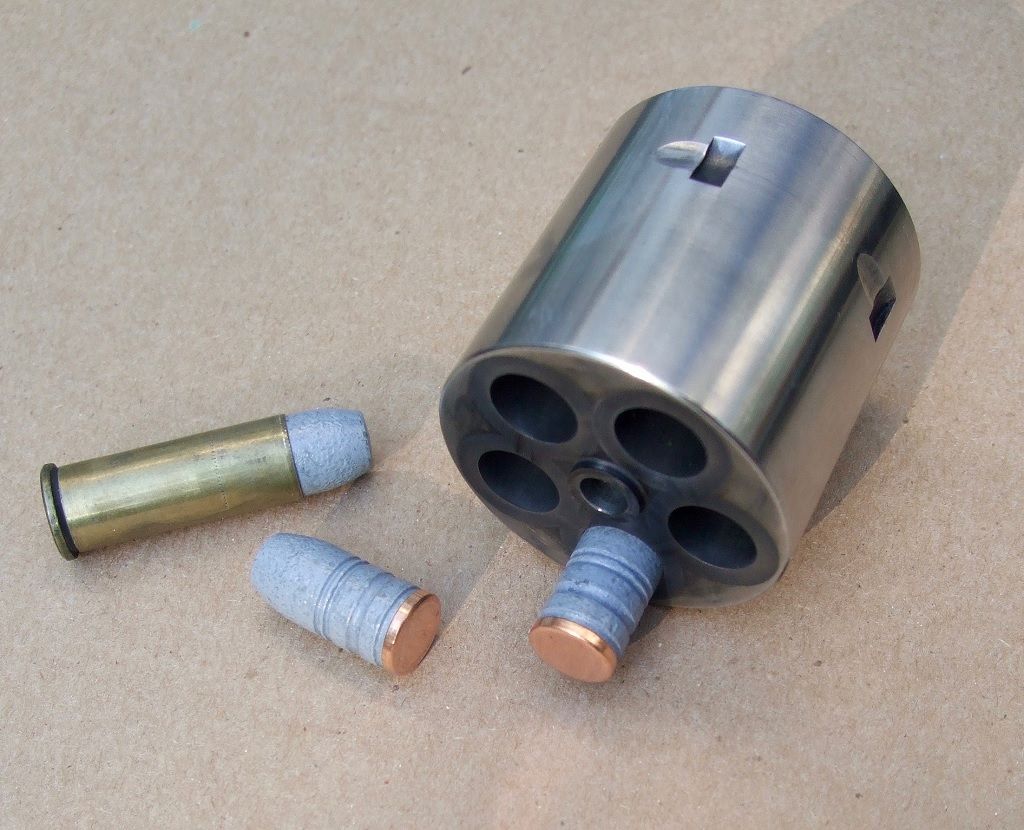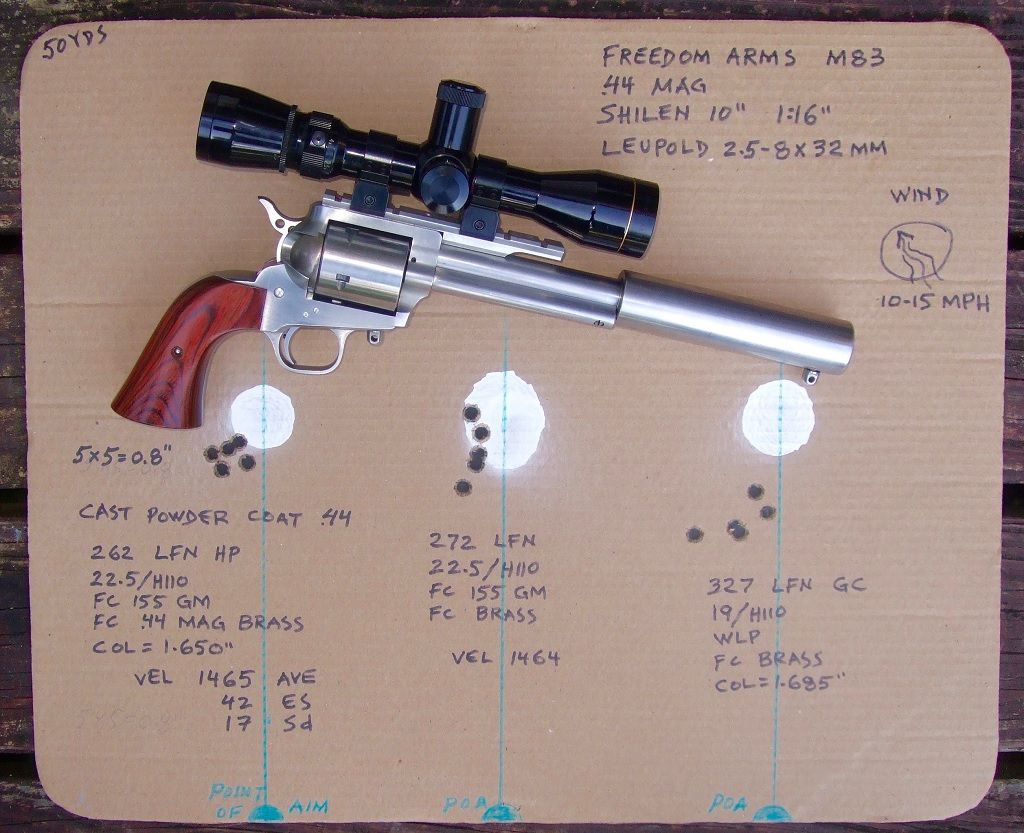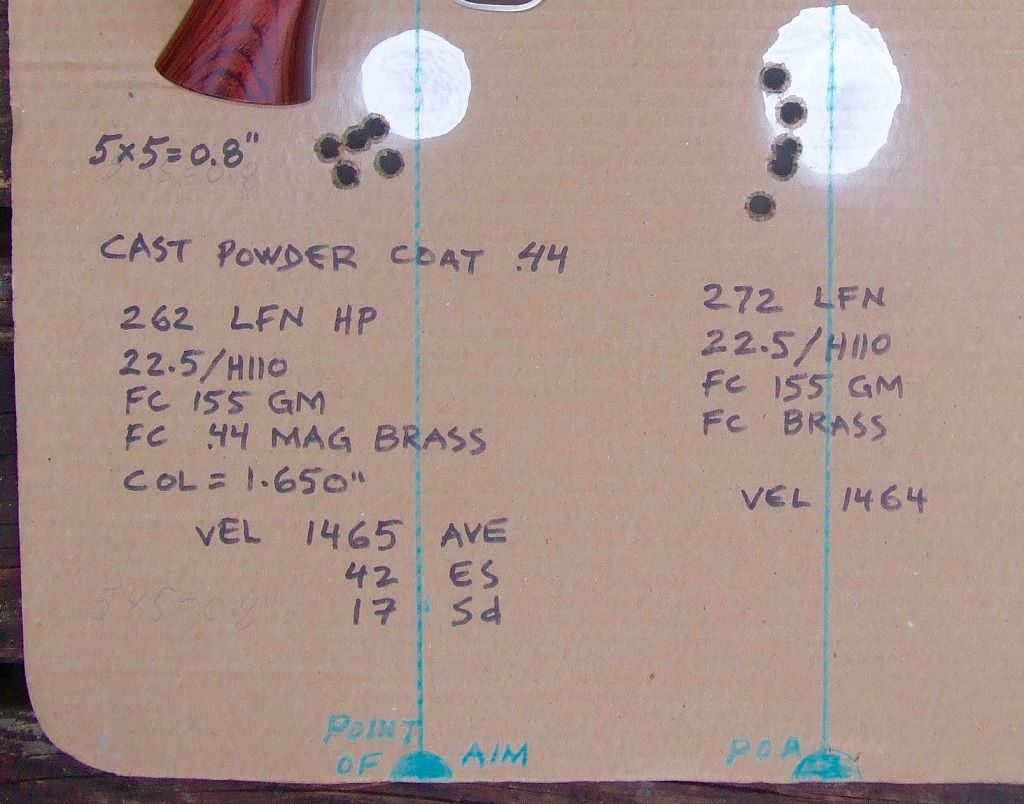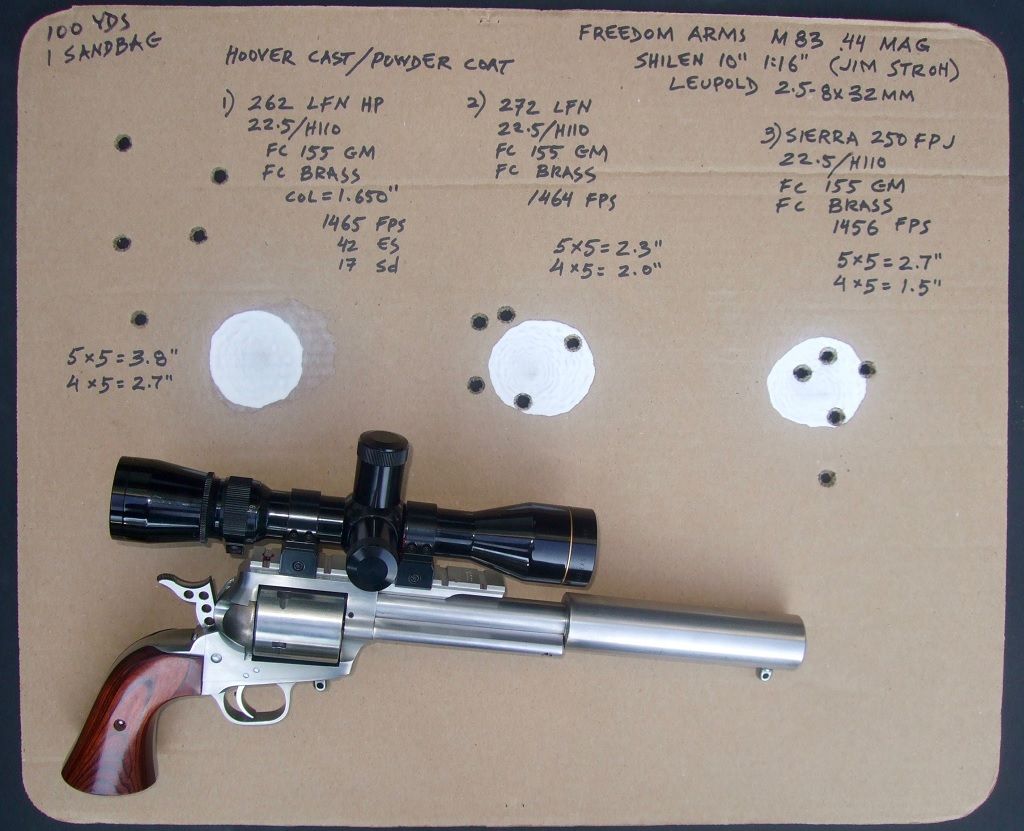|
|
Post by Lee Martin on Jul 12, 2016 19:33:43 GMT -5
Freedom Arms M83 .44 Mag cylinder. 327 grain LFN (Long Flat Nose) Gas Check, casting and Powder Coat by Tank Hoover. Bullets do not thumb-press through chamber exit holes. DEEP SEAT and roll crimp on beginning of ogive. Bullet contacts chamber throat (exit hole) as round is fully chambered. Tighter bullet sizing die would ease chambering, permit roll crimp in crimp groove. Charge of 19/H110 just about meets bullet base, easily room for one more grain. Firing rounds produced no evidence of leading of chamber leade or throat, nor in barrel forcing cone or bore.  Tank Hoover’s bullet making process: 1) cast. 2) powder coat. 3) size, or apply gas check & size. This Freedom Arms .44 cylinder has .429” exit holes. These 327 grain LFN GC bullets cast by Tank Hoover were sized .430-inch. Bullets do not thumb-press through chamber throats. Only the target can tell whether it harms accuracy to pinch a bullet in the exit hole. That no leading was found in chamber leade, throat, forcing cone, or bore after shooting Hoover’s PC bullets——262 LFN HP, 272 LFN, 327 LFN GC——suggests the powder coat process may introduce forgiveness to a cast bullet which grease on lead alloy does not.  The FORCING CONE is a necessary evil, analogous to the LEADE in a rifle barrel. Both must provide a smooth transition between the chamber exit and the LANDS of the rifling. As the revolver chamber is separate from the barrel, the forcing cone must accommodate minor chamber-to-bore offset. Too much forcing cone, or an off-axis forcing cone invites OBTURATION, or distortion of the bullet. A proper forcing cone cannot cure a bad barrel, nor make up for gross chamber-to-bore offset. By any measure this is a minimal forcing cone.  Cast .44 Powder Coat 327 grain LFN GC snugs forcing cone of Shilen barrel in Freedom Arms M83. Jim Stroh cut very short 11-degree cone on lathe. Bullet acts as alignment pin between chamber and bore——providing chamber throats and forcing cone are not grossly oversize. The 11-degree forcing cone is an industry standard, not a custom gunsmith invention.  Three Tank Hoover P0WDER COAT bullets were tried in the Freedom Arms .44 with Shilen barrel. Powder charge same as moderate charge of 22.5/H110 under Sierra’s excellent 250 FPJ and 210 JHC. One prior shot was fired at a separate target to check ZERO----the 262-grain LFN HP over 22.5/H110 printed 8” high @ 50 yards. To put POI (Point of Impact) close to center, the Leopold DOT reticle implanted edge of cardboard @ 6 o’clock (sketched in blue). 262 LFN HP is hollow point version of 272 LFN. While 262 LFN HP may appear more accurate on this target, human factor intervened on groups fired with 272 LFN and 327 LFN GC. Revolver fired from trunnion position on single sandbag.  Sketched in blue, Leupold Dot-on-crosshair reticle records very high impact of PC bullets @ 50 yards with scope sighted for Sierra 250 FPJ jacketed rounds. Same 22.5/H110 powder charge  REDDING COMPETITION SEATER remains Bradshaw’s favored die for effortless, straight-line seating with disparate nose profiles. Each hashmark represents .001-inch change in depth; “20” equals .020”, etc. In conjunction with seating, a Redding expander with built-in step helps start bullet square, with a minimum of flare at the mouth for long case life. Target 50 yards.  3 groups @ 100 yards 1) Cast LBT 262 LFN HP, powder coat. Promise of accuracy @ 50 yards give way to dispersion @ 100 yards. As first 4-shots group 2.7-inches, with 5th shot dropping to open 5x5 to 3.8-inches, actual dispersion cannot be concluded. 2) Cast LBT 272 LFN, powder coat. Consistency very likely to repeat, as 5x5=2.3-inches @ 100 yards, with 4X5 into 2.0-inches. Suspect that with the anneal from 400-degrees fahrenheit during powder coat, this bullet should prove excellent on soft skin game up to 400 pounds and, in some instances, greater weight. 3) Sierra .4295 250-grain FPJ silhouette bullet. Fired as a control, first 4-shots print 1.5-inches. Shot #5 is called “6 o’clock,” and, alas, opens group to 2.7-inches. The five Sierras fired post-sunset. (Velocity of “1456 fps” is incorrect. Five shots of Sierra 250 FPJ over 22.3/H110 average 1,426 fps.) Preliminary finding These powder coat bullets shoot. The cast 262 LFN HP and 272 LFN over 22.5/H110 could be and were interchanged with jacketed Sierra bullets without the firing of fouling shots to settle ZERO. However, Point of Impact (POI) of the cast powder coat bullets averages 8" higher @ 50 yards, and 14” higher @ 100 yards, than the Sierra 250 FPJ with the same powder & charge.  -Lee www.singleactions.com"Chasing perfection five shots at a time" |
|
|
|
Post by bradshaw on Jul 12, 2016 20:39:09 GMT -5
Big thanks, Lee, for posting.
Do not know why Powder Coat bullets record dramatically higher Point of Impact (POI) at 50 and 100 yards than Sierra jacketed of similar weight----and using same powder & charge. Perhaps PC exhibits longer BARREL TIME than the Sierra. The longer the time between powder ignition and bullet exit, the higher the muzzle of a handgun rises. It is not merely bullet weight. ( The same bullet accelerated more slowly strikes higher on the target.)
David Bradshaw
|
|
cmillard
.375 Atomic
   MOLON LABE
MOLON LABE
Posts: 1,996
|
Post by cmillard on Jul 12, 2016 20:56:17 GMT -5
fine shooting Bradshaw. very surprised the FA has that tight of throats
|
|
cmh
.401 Bobcat
  
Posts: 3,745
|
Post by cmh on Jul 12, 2016 21:18:07 GMT -5
..... and taking more notes  |
|
|
|
Post by bradshaw on Jul 12, 2016 22:15:36 GMT -5
fine shooting Bradshaw. very surprised the FA has that tight of throats What should surprise you is that groove diameters sometimes run on the loose side. The .454 Casull is a case----perhaps the case----in point. A loose groove may act to boost velocity. Accuracy inevitably suffers, unless chamber-to-bore alignment is very close, throats are firm, and----this big time----the bullet enters the barrel through a pristine, minimal forcing cone., all things the Freedom Arms shooter pays for and expects. David Bradshaw |
|
|
|
Post by Rimfire69 on Jul 13, 2016 7:20:40 GMT -5
In the close up pic of the frame it looks like a smear of never seize. Are you using it for cyl/base pin lube as opposed to oil, if so, it shouldnt pound out.
Great write up, great pics, and great shooting.
|
|
|
|
Post by bradshaw on Jul 13, 2016 8:57:32 GMT -5
In the close up pic of the frame it looks like a smear of never seize. Are you using it for cyl/base pin lube as opposed to oil, if so, it shouldnt pound out. Great write up, great pics, and great shooting. rimfire69..... thank you for the kind words. Yes, a trace of Anti-Seize Compound, a favorite grease for single action ratchet, rub, base pin applications, as well as hammer and trigger pins, various clockwork. As well, Moly Disulfide chassis grease receives plenty use around here. Prefer automotive lubes on guns for proven reasons. About 1960-61, the great High Power rifleman Sam Burkehalter, one of my instructors in the M-1 Garand, had me switch from World War II Lubriplate white grease----"water gums it up"----to a synthetic. Some guns are more forgiving of little or no lubrication, Ruger single actions high on that list, yet long periods in practice and on the firing line in silhouette demonstrated, leastwise for this shooter, steel likes lubrication. As the Rugers would say, "The wrong lubrication is better than no lubrication." Want to see galling happen fast? Run a Remington M700 hard with dry lugs. Steel alloys and their heat treatment (or lack thereof) really are beyond softball internet discussions. Suffice to say, traditional Ruger steels and heat treatment take a back seat to no one, no other revolvers have been put through such mass "testing," and, as an addendum, Old Man Ruger went about setting a standard for manufactured durability. Of all bolt action rifles, the Remington is one of the most susceptible to galling of locking lugs and locking lug abutments. As a side track, stainless steel absolutely wants to be lubricated, even when runs against dissimilar carbon steel or dissimilar stainless. Against hard cold, dry moly disulfide helps to prevent the "welding" of water frozen on steel. Thus, even winter-sensitive actions like .22 semi-auto rifles and pistols are more reliable with synthetic motor oil or dry moly lube. My trigger jobs are done to work cold hot dry wet with lubrication either applied or having migrated into sear parts. One exception comes to mind: locking lug(s) of Thompson/Center Contender should be dry----to prevent inertia-unlocking on recoil. David Bradshaw |
|
|
|
Post by BigBore44 on Jul 13, 2016 9:27:36 GMT -5
Mr Bradshaw
Is the never seize good on both blue and SS guns?
Also, the Redding comp seater, does it work with any nose profile, WFN included? 44 caliber specifically...?
Almost forgot, what is that at the end of your FA bbl? Weight, or?
Thanks
Ray
|
|
|
|
Post by hoover on Jul 13, 2016 13:41:54 GMT -5
Great write up David! The higher POI is interesting with the PC slugs compared to the jacketed bullets even though the PC slugs had higher velocities. Normally, this lowers POI in a handgun. Perhaps the pressure curve is steadier, with less spike, causing longer barrel time with the PC slugs, than the jacketed bullets. I don't know, but interesting non the less! Glad they shot for you! Great shooting!
|
|
|
|
Post by bradshaw on Jul 13, 2016 14:45:25 GMT -5
Mr Bradshaw Is the never seize good on both blue and SS guns? Also, the Redding comp seater, does it work with any nose profile, WFN included? 44 caliber specifically...? Almost forgot, what is that at the end of your FA bbl? Weight, or? Thanks Ray Ray..... whatever is in Anti-Seize Compound, learned about in high school from an analytical, mostly self-taught, hotrod ding mechanic. Taught himself to weld starting at 12, had chopped and channeled a '50 Ford coupe by the time he got his driver's license at sixteen. Needless to say, wheelies and smoking rubber were part of the street scene in those days. He used Anti-Seize, a.k.a. Never-Seize, on manifold bolts, exhaust fasteners, and plenty other places. Wouldn't be surprised to hear that Anti-Seize labeled Permatex, International Harvester, Catepillar are made by the same company. Photos of my ordnance show Anti-Seize on blue and stainless. The REDDING COMPETITION SEATER should work with WFN, although a flat plug works fine for me. Barrel on the M83 .44 is by Jim Stroh: Shilen blank, turned to Freedom Arms taper out to end of ejector housing, with a recoil step, the forward portion finished close to 1.25" blank diameter, with straight 11-degree crown, and very short, 11-degree forcing cone. Its weight helps to conserve a somewhat worn anatomy without screwing a pickle on the end. Part of the overall experiment. David Bradshaw |
|
|
|
Post by bradshaw on Jul 13, 2016 14:55:13 GMT -5
Great write up David! The higher POI is interesting with the PC slugs compared to the jacketed bullets even though the PC slugs had higher velocities. Normally, this lowers POI in a handgun. Perhaps the pressure curve is steadier, with less spike, causing longer barrel time with the PC slugs, than the jacketed bullets. I don't know, but interesting non the less! Glad they shot for you! Great shooting! Tank.... beaucoup thanks for sharing your expertise. And bullets, which expand the realm of cast projectiles. Seems Lee Martin and this shooter both have been fighting the wind of late, with Lee getting the better of it. Higher Point of Impact for PC (vs Jacketed)"Perhaps the pressure curve is steadier, with less spike, causing longer barrel time with the PC slugs..."----certainly plausible, analogous to the effect of a slower powder. David Bradshaw |
|
|
|
Post by sixshot on Jul 13, 2016 23:04:01 GMT -5
This is a guess but perhaps the powder coated bullets being softer are lengthening because of the soft alloy & high velocity, this would lead to more "barrel time" & higher impact. Would be interesting to have Tank water quench some powder coats right out of the toaster oven & have David re-shoot the test to see if a somewhat harder powder coated slug would impact lower on the target, I'm guessing it would.
You could do it with straight linotype but the weight would be off. Some very good shooting with interesting results, one things for sure, powder coating is here to stay. It allows us to do things with a softer alloy that isn't possible with a lubed bullet, with or without a GC.
Dick
|
|
|
|
Post by cherokeetracker on Jul 14, 2016 7:55:51 GMT -5
Great write up David! The higher POI is interesting with the PC slugs compared to the jacketed bullets even though the PC slugs had higher velocities. Normally, this lowers POI in a handgun. Perhaps the pressure curve is steadier, with less spike, causing longer barrel time with the PC slugs, than the jacketed bullets. I don't know, but interesting non the less! Glad they shot for you! Great shooting! Tank.... beaucoup thanks for sharing your expertise. And bullets, which expand the realm of cast projectiles. Seems Lee Martin and this shooter both have been fighting the wind of late, with Lee getting the better of it. Higher Point of Impact for PC (vs Jacketed)"Perhaps the pressure curve is steadier, with less spike, causing longer barrel time with the PC slugs..."----certainly plausible, analogous to the effect of a slower powder. David Bradshaw I have a question about this, for first off David, and then maybe Tank Hoover and Sixshot can answer too. The bullet diameters surely are different. I did not see a comparison photo, but a measurement would suffice. Would a larger diameter from the Powder Coating make any difference? I am still referring to the POI and results obtained or revealed. Before everyone goes off on me screaming "They were sized after the PC" ,,, I want to point out that I am asking partly because I have used some PC bullets, and I have also PCed my own bullets and then of course sized them afterwards. Sometimes there is a little springback. So to try to eliminate this, I have sized some of them twice. I do shake off the bullets before baking then so that I do not have a thick coating or build up on them. Also I have quenched my PC bullets in ICE water. trying to see about different results. I have not been able to shoot enough for a legit comparison. I might point out that I only shoot iron sights and even with a NON trunion rest, that I use, I do not feel that my shooting is going to be as accurate as someone with a scope or even a red dot setup. So this write up is a welcome read, and I do want to thank all that have been involved with this endeavor. Recently I did PC some bullets for my 44 mag. It bears a Factory barrel and cylinder. Measured throats at .429 and bullets sized at .430 . The accuracy was improved with the PC bullets. No smoke, and no leading is nice too. This has got me even more curious as to the answers on the POI. Thanks. Charles |
|
|
|
Post by bradshaw on Jul 14, 2016 11:32:06 GMT -5
Tank theorizes that a lead bullet exhibits a longer BARREL TIME than a jacked bullet of similar weight. Specifically, Tank applies the theory applies to POWDER COAT. Based on the sensation of RECOIL & FOLLOW THROUGH, I believe the jacketed bullet drives pressure more sharply than lead, with faster rear-barrel acceleration. (This discussion may provoke a call to Dr. Kenneth Oehler. Other names come to mind Allan Jones and Ron Reiber.)
Velocity of the cast PC 262 LFN HP and PC 272 LFN over 22.5/H110 averages 1,464 fps.
Velocity of the Sierra 250 FPJ over 22.3/H110 averages 1,426 fps.
Velocities nearly identical. Yet the lead PC bullets strike 7-8-inches above the Sierra at 50 yards; 14-inches above the Sierra at 100 yards. In 1/4-mile drag racing, it was common to see the car with the slow elapsed time record high MPH at the finish line. My interest is to learn where Powder Coat fits in the cast vs jacketed picture. At this point I believe that, down the road, POWDER COAT CAST will turn the linear connection between cast and jacketed into a triangle. PC is that important.
The bullet diameter debate sugars off to:
1) does it fit in the cylinder?
2) is it ACCURATE?
There may be a reader or two here who believe that to squeeze a bullet through the cylinder throat kills accuracy. Those folk were not on hand when this shooter scored 7x10 quarter-size silhouettes off the rail 205 meters with a Dan Wesson M44 8-inch Vent Heavy .44 Magnum. Ammo: Federal 44A 240 JHP. I borrowed World Standing Champion Tom Calasanto's spotter, Jimmy Gibb, who, along with Colasanto and various others, including three from Dan Wesson Arms, watched the bullets fly downrange through spotting scopes. The light was perfect, with the sun glinting the base of each bullet. After the regional championship I brought the M44 to DWA, where a smith miked the chamber throats at .426-inch! How in Hell could those bullets have gone from .426" exit holes into a .428-429-inch groove diameter and hit little stinking targets two football fields two end zones away? Tom Calasanto was the first to exclaim, "Those bullets fly like lasers!"
Now we have lead bullets, Powder Coated & sized .430", squeezing through .429" exits to fly pretty straight. Nearly all shooting in a pretty steady wind.
A revolver is an orchestra, a mixture of dimensions. Some combinations work, some don't. The closest we come to a formula for ACCURACY is to have specifications on the minimal side. Include chamber-to-bore runout of .006" or less; less is better. (Here again, individual numbers can be less critical that the ORCHESTRA of DIMENSIONS.
Individual dimensions which kill accuracy:
1) lousy forcing cone.
2) irregular bore.
3) grossly oversize chamber exits.
David Bradshaw
|
|
|
|
Post by cherokeetracker on Jul 14, 2016 13:43:06 GMT -5
My way of thinking was that after Powder coating the bullets maybe the BHN was a little different and the said Bullets upset better and sealed better (even though with the PC the velocity was increased, because of Lubricity.) When you have both PC and jacketed bullets turning in the near same time, it cause me to scratch my head. ( thinking about Tank Hoovers theory )
But on the other hand,,,, I do not need to know every little thing about electricity to enjoy being able to flip a switch and the lights come on. Sometimes when things do not correlate to our theories or our way of thinking, it seems to throw a wrench in the gears. Like everything we learned about cars and engines most of it had to be thrown out the window when it came to boats with inboards.
On the velocity and " Barrel Time" I also want to check with some one who might have been working with or knowledgeable about HY-Tek bullets. This reason would be for a basis of comparison hopefully.
Until we can figure this out, or get some relief from outside help, I will just keep enjoying the PC bullets. It would be fun to learn the correct answer to some of these questions. I am not going to attempt to rule out any theories or deny facts. The end results have been good, but I still like more fully understanding things.
Charles
|
|



















